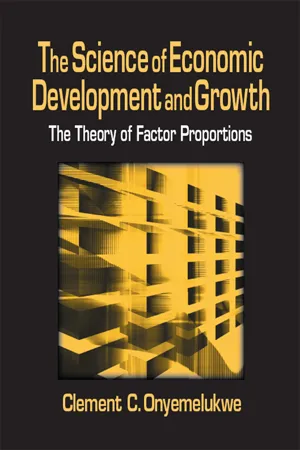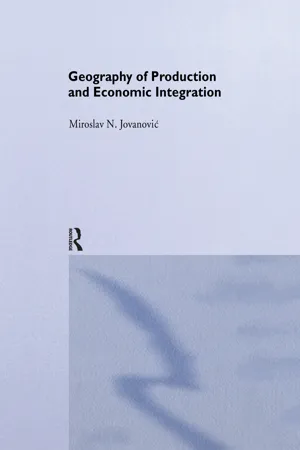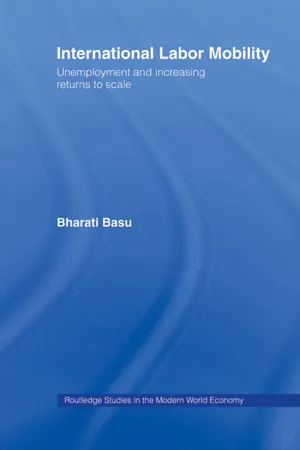Economics
Capital Mobility
Capital mobility refers to the ease with which financial capital can move across borders to seek the highest returns. It is influenced by factors such as interest rates, exchange rates, and government policies. High capital mobility can lead to increased investment and economic growth, but it can also make countries more vulnerable to financial crises and speculative movements.
Written by Perlego with AI-assistance
Related key terms
4 Key excerpts on "Capital Mobility"
- eBook - ePub
The Science of Economic Development and Growth: The Theory of Factor Proportions
The Theory of Factor Proportions
- C.C. Onyemelukwe(Author)
- 2016(Publication Date)
- Routledge(Publisher)
For example, capital could leave a capital-abundant country, where it has lower rent, and migrate to a capital-scarce country, where it will achieve higher rent. Labor would, as a result, have become more abundant in the capital-abundant country. Therefore wages will fall. But the income of the owners of capital will rise to become equal to that in the capital-scarce country. The opposite will happen in the capital-scarce country. Capital Mobility, like trade, redistributes income from a country’s relatively scarce factor to the relatively abundant one. It is argued that factor mobility in this way makes a country better off because the “ability to exchange factors, like the ability to trade goods, widens opportunities.” 1 In effect, widened opportunities (whatever opportunities means in this case) are regarded as a requirement for economic growth. Today, the factors that are regarded as transferable are capital, labor, and technology. Of these, technology has not always been regarded as a mobile factor. The importance of technology and its mobility seem to have increased with the emergence of new growth theory. Land is said to be an immobile factor. Recall that the conventional literature does not recognize material as a factor because of traditional economic ambivalence about the role of material. Instead, material is often classed in a characteristically unscientific language as a kind of working capital. Yet material is historically the oldest of the mobile factors. Conventional economics takes the position that a country’s factor endowments do not provide it with the best combination to maximize welfare. So, it is thought, each country needs to export and import products or factors - eBook - ePub
- Miroslav Jovanovic(Author)
- 2002(Publication Date)
- Routledge(Publisher)
Foreign direct investment reflects the goal of an entrepreneur from country A to acquire a lasting interest (including management) in an asset in country B. In principle, FDI asks for freedom of establishment and, if possible, national treatment in foreign markets. This distinct type of international capital flow has a strong risk-taking and, often, industry-specific dimension. In addition, it is coupled with a transfer of technological know-how as well as management and marketing skills.Capital moves among countries in the form of portfolio and direct investment. Portfolio investment is most often simply a short-term movement of claims that is speculative in nature. The main objectives include an increase in the value of assets and relative safety. This type of Capital Mobility may be prompted by differences in interest rates. The recipient country will probably not wish to use these funds for investment in fixed assets that must be repaid in the long term, so these movements of capital may be seen by the recipient country as hot, unstable and ‘bad’. Volatility of portfolio investment complicates their analysis. The large number of portfolio investments, made in many cases by brokers, obscures who is doing what and why.Foreign direct investment is often the result of decisions by TNCs. Therefore, FDI may be a part of a proxy for the investment and location activities of TNCs (keeping in mind that TNCs may control operations abroad simply by issuing licences).Globalisation
Liberalisation in the national and international economy is a policy choice of governments , primarily in the developed world. It is linked with privatisation and downsizing of the activities of the public sector and the expansion of the activities of the private sector. Globalisation of the economy and production is a fact. It is the outcome of the behaviour of firms (TNCs), their organisation, changing technology in production and distribution, control and finance, as well as economies of scale. In part, it is also the consequence of a change in the behaviour of consumers (declining loyalty to national producers and some national products)1 - eBook - ePub
- Anwar Shaikh(Author)
- 2007(Publication Date)
- Routledge(Publisher)
Part IV Globalization, Capital Mobility, and competition
Passage contains an image
10 Capital account liberalization, free long-term capital flows, financial crises, and economic development1 *
Ajit Singh1 Introduction: Main issues and the international policy context
The main objective of this paper is to review the theoretical issues and available empirical evidence on capital account liberalization, which in addition to being of interest in their own right are of importance to present multilateral discussions in two international policy contexts. First, they are a concern in the debate on the New International Financial Architecture (NIFA). Second, they are part of the post-Doha agenda in the WTO, in relation to FDI flows. The focus of this paper is on developing countries and it considers policy from the perspective of (1) economic development and (2) the global rules of the game rather than the economic policy within individual countries. The paper essentially examines the question: What kind of global economic order in relation to capital flows can best serve the interests of developing countries?Capital account liberalization is the area where there is the greatest disconnection between economic theory and actual events in the real world. In analyzing liberalization of capital flows, it is customary to distinguish between short-term (e.g. portfolio flows and short-term bank loans) and long-term flows (e.g. FDI). Neoclassical theory suggests that free flows of external capital (including short-term capital) should be equilibrating and help smooth a country’s consumption or production paths. However, in the real world, exactly the opposite appears to happen. Liberalization of the short-term capital account has invariably been associated with serious economic and financial crises in Asia and Latin America in the 1990s. The proponents of neoclassical theory argue that the case for free capital flows is no different from that for free trade – the former could simply be regarded as a form of intertemporal trade. - eBook - ePub
- Bharati Basu(Author)
- 2004(Publication Date)
- Routledge(Publisher)
During the last few decades, labor, capital, finance and all forms of resources have been flowing across national borders to take advantage of opportunities. New technology is spilling over the countries and the information system is getting more and more integrated. The volume of trade is growing, and more interestingly we are seeing more intra-industry trade. Goods that were considered non-tradable are entering the world market. The development of world organizations (such as the World Bank, International Monetary Fund, World Trade Organization and European Central Bank), and the increasingly active role of the United Nations during the twentieth century have only complemented the growth of this new world economy. In his study on technology spillover, Helpman concludes, ‘there are significant cross country links that are driven by foreign trade and investments’ (1999: 17–30).In this new world environment international labor mobility creates new implications. International labor mobility is another form of trade among nations. It is trade in factors. Thus it is an important tool for world economic integration. Even when globalization was at its infant stage, labor mobility contributed significantly to nations' growth.2 Of all different types of mobility across national borders, labor mobility is slightly different. Thus, although sometimes labor migration as a substitute for trade in goods has similar economic consequences, it meets radically different political acceptability. International labor migration faces more restriction than international trade in goods. During the 1980s, for instance, the European Union imposed serious restrictions on labor immigration while they followed free trade in goods.Mobility of workers between nations is also different from movement of any other factors of production across national boundaries. For any other factors the owners of the factors of production do not have to move to another country. They can provide their services to the host country while staying in their resident country. This is also true for guest workers who, although they move in person to the host country, are not entitled to many amenities in that country. But international labor migration means a flow of workers together with their services between countries.
Learn about this page
Index pages curate the most relevant extracts from our library of academic textbooks. They’ve been created using an in-house natural language model (NLM), each adding context and meaning to key research topics.



